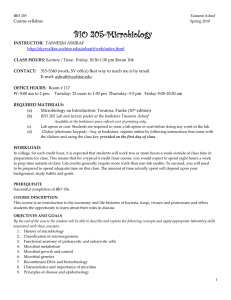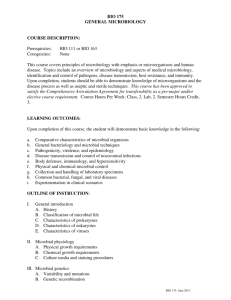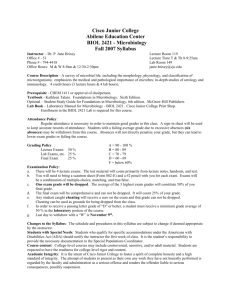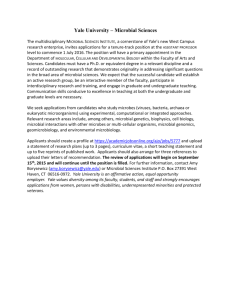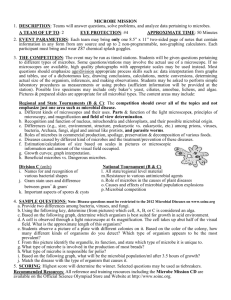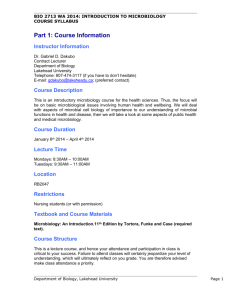BIO 205-Microbiology
advertisement
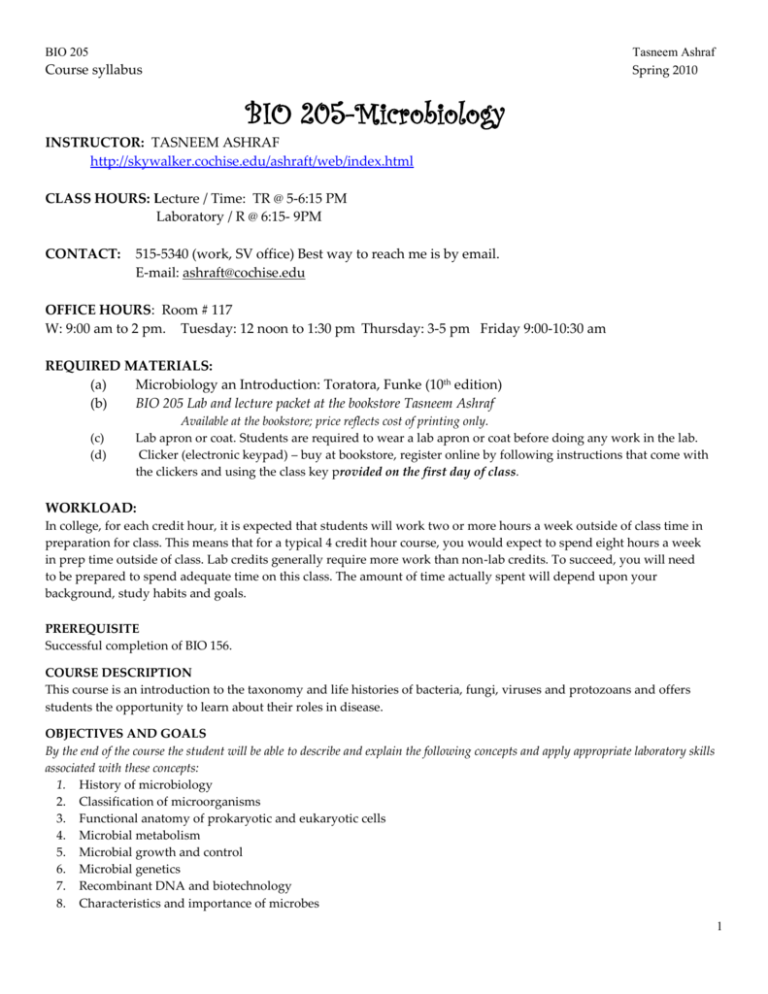
BIO 205 Tasneem Ashraf Spring 2010 Course syllabus BIO 205-Microbiology INSTRUCTOR: TASNEEM ASHRAF http://skywalker.cochise.edu/ashraft/web/index.html CLASS HOURS: Lecture / Time: TR @ 5-6:15 PM Laboratory / R @ 6:15- 9PM CONTACT: 515-5340 (work, SV office) Best way to reach me is by email. E-mail: ashraft@cochise.edu OFFICE HOURS: Room # 117 W: 9:00 am to 2 pm. Tuesday: 12 noon to 1:30 pm Thursday: 3-5 pm Friday 9:00-10:30 am REQUIRED MATERIALS: (a) Microbiology an Introduction: Toratora, Funke (10th edition) (b) BIO 205 Lab and lecture packet at the bookstore Tasneem Ashraf (c) (d) Available at the bookstore; price reflects cost of printing only. Lab apron or coat. Students are required to wear a lab apron or coat before doing any work in the lab. Clicker (electronic keypad) – buy at bookstore, register online by following instructions that come with the clickers and using the class key provided on the first day of class. WORKLOAD: In college, for each credit hour, it is expected that students will work two or more hours a week outside of class time in preparation for class. This means that for a typical 4 credit hour course, you would expect to spend eight hours a week in prep time outside of class. Lab credits generally require more work than non-lab credits. To succeed, you will need to be prepared to spend adequate time on this class. The amount of time actually spent will depend upon your background, study habits and goals. PREREQUISITE Successful completion of BIO 156. COURSE DESCRIPTION This course is an introduction to the taxonomy and life histories of bacteria, fungi, viruses and protozoans and offers students the opportunity to learn about their roles in disease. OBJECTIVES AND GOALS By the end of the course the student will be able to describe and explain the following concepts and apply appropriate laboratory skills associated with these concepts: 1. History of microbiology 2. Classification of microorganisms 3. Functional anatomy of prokaryotic and eukaryotic cells 4. Microbial metabolism 5. Microbial growth and control 6. Microbial genetics 7. Recombinant DNA and biotechnology 8. Characteristics and importance of microbes 1 BIO 205 Course syllabus 9. 10. 11. 12. Tasneem Ashraf Spring 2010 Principles of disease and epidemiology Microbial mechanisms of pathogenicity Defenses of the host Practical applications of immunology, anti-microbial drugs, microbial diseases, environment and applied microbiology COURSE WEBSITE: Go to www.cochise.edu and then click on Online Instructions. Select the WebStudy links and login. You should be automatically enrolled in this class. If you are not, contact Tasneem. Please make sure you have a valid, current email address listed on your preferences so Tasneem can contact you!! If you don’t have an email address, go to the library, get on Internet and create a free email account through a free website such as Cochise College, Hotmail, Yahoo etc. Ongoing announcements will be posted in the announcement folder - very important for you to check the announcements regularly. (At least three times a week) COURSE RECOMMENDATIONS: You will be required to do college level work- this level of performance is absolutely mandatory; a reading level of 110 or exemption, MAT 82 or placement in, or completion of MAT 122 or higher would be recommended. Course Specific Outcomes: Students will be able to: 1. 2. 3. 4. 5. 6. 7. 8. 9. 10. 11. 12. History of microbiology Classification of microorganisms Functional anatomy of prokaryotic and eukaryotic cells Microbial metabolism Microbial growth and its control Microbial genetics Recombinant DNA and biotechnology Characteristics and importance of microbes Principles of disease and epidemiology Microbial mechanisms of pathogenicity Defenses of the host Practical applications of immunology, anti-microbial drugs, microbial diseases, environment and applied microbiology COURSE LOGISTICS: 1. Quizzes and Examinations: (a total of 45 % of the course grade): a. PREP QUIZZES: (10% of the course grade). PREP quizzes are planned for each class meet, unless there is a test scheduled for that day. All prep quizzes will be given at the beginning of each class period to ensure you have the read the new chapter and are ready for class lecture. There’s a second benefit to frequent quizzing: the more you spread out your learning and review of material, the more likely you are to remember the information and retain it over time. Consult the course schedule to anticipate what chapters you need to read for the coming class. Prep (clicker) quizzes will be multiple choices and you will take them with your clicker. When final grades are calculated, I will drop two of your quizzes towards your total final grade calculations. 2 BIO 205 Tasneem Ashraf Spring 2010 Course syllabus b. EXAMINATIONS: (30% of the course grade): Five lecture examinations will be given during the semester. The exam includes a multiple‐choice section with somewhere between 25 and 35 multiple choice questions, as well as a short answer section (consisting of short essay, fill‐in‐the‐blank, labeling illustrations, etc.). You must answer all essay questions with complete sentences or you will lose points. EXAM I – Ch. 1, 10, 4, 12 EXAM II – Ch.6, 7, 5, EXAM III – Ch. 8, 9 EXAM IV – Ch.13, 14, 15 FINAL EXAM (16, 17. 18, 20) c. Lecture exam TEST CORRECTIONS: You may correct lecture exams one through four to add up to 10% of the total value of the exam to your original score. Students have until the next class after receiving their graded exam to make corrections. For example: If a test is worth 100 points then the correction rubric is as follows: Short answer portion: A student may earn a maximum of 5 pts. If s/he correctly re-answer all missed parts of his/her short answer portion. If a student correctly re-answers 80% of the questions she missed, I will add 0.80 X 5 pts = 4 points to her grade. If another student only correctly re-answers 30% of the questions he missed, I will add 1.5 points (5 pts X 0.30 = 1.5) to his grade. A student may not improve his/her grade in excess of 100%. Multiple choice portion: A student may earn a maximum of 5 pts. if s/he correctly re-answer all parts of his/her multiple choice portion. For example, if you correctly answer 95% of the multiple choice questions on the take-home portion, I will multiple 5 by 0.95 to determine that you will have 4.75 added to your exam score. If you miss an exam, you lowest grades from another exam will be substituted and you can’t do test corrections. See the “Correcting Tests” handout in this lecture packet for detailed 2. Homework: (15% of the course grade) you have assigned homework for each week under WebStudy. WebStudy assignments are available each week on a Monday and will end the following Tuesdays at 11PM unless otherwise noted. You cannot make up any missed assignments, so please get into the habit of taking assignments on time, no exceptions will be made! Also in mind, that you can take the quizzes multiple times however ONLY the BEST ATTEMPT WILL BE IN YOUR GRADE BOOK. 3. Laboratory: (35 % of the course grade) You are expected to come to laboratory having read that day’s experiments and having a general idea of what you will be doing. i. Portfolio. Students will keep a portfolio of their in-class work and out-of-class assignments. The portfolio will be due on exam days. Each will be worth between 50-60 points and may include both lecture and lab assignments. I will grade you on the effort and quality of your work (e.g. thoroughness of responses, proper grammar, correct spelling, complete sentences, etc.). ii. Initials. Some portfolio items must be initialed for full credit. You must be present in class (or give your completed assignment to a classmate to be initialed) on the day it is due. You cannot obtain initials after the due date. The point of initials is to ensure you finished in a timely fashion. iii. Due items within portfolios will be given all semester long. Near the end of the semester you will take a LAB EXAM (25%), more on this later. 3 BIO 205 Tasneem Ashraf Spring 2010 Course syllabus 4. Classroom response system for participation (5% of the course grade): We will use clickers in class on a daily basis- even on test days. You will also need them to take quizzes, as well during class participation and responses in-class questions. Therefore, you must remember to bring clickers to class every day. If you forget to bring your clickers on the day of the quiz or exams, you will be allowed on two occasions only to turn in handwritten sheets, which I will grade manually. If you forget to bring your clicker on the day for class participation, you will not be allowed to submit handwritten sheets. You will receive points for class participation, with your clicker throughout the semester and will earn a total number of points, out of 30 semester’s end for participation. You will receive points for trying to answer the question and not be penalized for incorrect answer. 5. Disease detectives (5% of the course grade): Working in your group, you will solve an Outbreak the same way as epidemiologists. Your final report will include a review of current literature on the topic, data, including case definition and index case, and appropriate tables. The Discussion & Conclusions should include how you arrived at your conclusions (source, method of transmission) and prevention and treatment. You will need to do relative risk calculations to determine the source of the outbreak. Later in the semester handout will be given with more detail instructions. MAKE-UPS TESTS: If you miss an Exam, your missed grade will be substituted by the lowest points earned from the other given exams. Your ONE lowest Exam grade will be dropped at the time when Final Grades are calculated. THERE IS NO MAKE-UP FOR THE LAB FINAL! ACADEMIC HONESTY: Cheating and plagiarism are unethical. Students are expected to do their own work. Students must present ideas in their own words or give proper credit to original sources if text is used verbatim from any outside sources. If students work together on an assignment, they must type their answers separately. Plagiarism is the use of another person’s words and/or ideas without adequate acknowledgment. This includes copying or cutting and pasting from online sources, taking information from a book or article, copying someone else’s paper, or having someone else do your work for you. When a student uses research sources, those sources must be properly documented. Students found cheating or intentionally plagiarizing will receive a zero for the assignment and may be dismissed from the class with a failing grade. Plagiarism will not be tolerated by Tasneem!!!! 4 BIO 205 Course syllabus Tasneem Ashraf Spring 2010 GRADING POLICY: On all work done in the class; grades will be assigned on the following basis: GRADE SCALE: A = 90%-and above, B = 80%-89%, C = 70%-79%, D = 60%-69%, F = below 60% Grade Standards—for Cochise College A: The highest academic grade possible; an honor grade which is not automatically given to a student who ranks highest in the course, but is reserved for accomplishment that is truly distinctive and demonstrably outstanding. B: A grade that denotes achievement considerably above acceptable standards and mastery of course materials C: Indicates a satisfactory degree of attainment and is the least acceptable standard for graduation from college or additional studies within the discipline. This grade implies completion of the minimum outcomes identified in the course curriculum. D: Denotes a limited understanding of the subject matter, meeting only the minimum requirement for passing the course. This grade will not transfer to another institution of higher education nor is it acceptable for additional studies within the discipline. F: Indicates inadequate or unsatisfactory attainment, serious deficiency in understanding of course material, or failure to complete requirements of the course. Accessing grades online: I use Snapgrade separate grading software. I will be sending you an email from snap grade (https://snapgrades.net/) with instructions on how to log in within this online grade book sometimes by the second week of the semester. Periodically grades will be transferred from WebStudy to Snapgrade. Please note that as soon as you enter an assignment, online test, forum, WebStudy assignments I cannot automatically grade it. Many assignments require for me to read and review before I can assign a grade. Since I am teaching four science classes allow about a week after the deadline for these to be posted. Attendance policy: Attendance will be taken at the beginning of each class meeting. Tardiness is highly disruptive and annoying. In an intensive course like this one attending each lecture is very important, as even one absence can cause you to be behind the rest of the class. After four (4) absences I will reserve the right to drop you from the course. There are no make-up laboratories and therefore you are not allowed to miss a laboratory without penalty. I will assign a zero to any missed lab. If you miss a class it is your responsibility to obtain notes, and or supplementary materials by visiting the WebStudy website, contacting other students, or come see me. 5 BIO 205 Course syllabus Tasneem Ashraf Spring 2010 EMAIL COMMUNICATION AND ONLINE WRITTEN ETIQUETTE: Please use BIO 205 in any communication to me in the subject matter, I teach about 3-4 sections and it is hard for me to know exactly what your situation maybe be that needs attention. This is a college class. Proper English is required and expected. All sentences you write in emails and in online discussions for this course must abide by the following criteria. a. You must use complete sentences. This means start with a capital letter, contain at least a noun a verb an must end with a proper appropriate punctuation mark. b. Writing all words in lower case is unacceptable. c. Do not write in all capital letters unless your intention is to yell at your recipient, as messages in all Capital letters are construed as yelling. The pronoun “I” must be capitalized in all uses. d. The pronoun “you” must be spelled y-o-u and not “u”. e. All other words must be spelled correctly and in their entirety. f. Please refresh your memory on the differences between there/their/ they’re, to/ two/too and its/it’s so that your use. g. All emails must be signed with your name and make sure you mention the exact class you are enrolled in. NOTE: Your success in this class is up to YOU. I am here to help you understand difficult material, but it is your responsibility to read assigned material, to take notes while listening to the audio (wmv files) lectures and to organize information so that you can retrieve it. If you need help improving your study skills, email me. I won't know you're having trouble till test time, and it might be too late! Exams will be primarily composed of a blend of multiple choice, definition, short answer and essay question. Students needing or meeting needs of incomplete grades please check with me and we have to follow the college’s policy on that. ADA Coordinator in the Special Needs Office: Students wishing to receive an accommodation for a disability should make an appointment with the ADA Coordinator in the Special Needs Office. Please contact: Ken Laux, Director of Disability Services: Cochise Community College, 901 N Colombo Ave, Sierra Vista, Arizona 85635-2317. Tel #(520) 515-5337SV and (520) 417-4023 (DC) email at: lauxk@cochise.edu Assessment Cochise College provides accessible educational opportunities that are responsive to a diverse population and lead to constructive citizenship, meaningful careers, and lifelong learning. Cochise College is committed to continuous improvement in order to provide the best possible service. A key part of this commitment involves assessing student learning outcomes. Assessment, which occurs apart from the regular grading of student work, is conducted by faculty using tests, research papers, projects, presentations or standardized examinations to discover how well students who have passed a course actually achieved the expected learning goals. Faculty members analyze the results so they can develop strategies to help improve student learning in future classes. 6 BIO 205 Course syllabus Tasneem Ashraf Spring 2010 Correcting tests 1. Your corrected test is due the next class after you receive it. No late papers will be accepted. No exceptions. 2. You must follow all instructions on this page exactly. If you fail to follow instructions you will not receive additional points. You will not be allowed a second chance to turn in your corrected test for extra points. 3. You must fully correct both the short answer and clicker section to receive any additional points. 4. Refer your syllabus if you can’t remember how I determine how many points to add to your exam. 5. You can only earn a maximum of 10% of the total value for the short answer part ( = 5 pts) by correcting your short answer portion, with the following exceptions. a. You can NOT correct bonus questions nor can you receive greater than 100 pts. on your corrected test. b. Remember that you also will help raise your grade by retaking the clicker section. 6. MULTIPLE CHOICE PORTION a. Re-answer your multiple choice portion. b. On the day you turn in your written portion of your test corrections, be ready with your clicker to resubmit your multiple choice answers into the computer at the beginning of class. b. We will calculate what percentage you earn on your multiple choice corrections and multiply that by 5 pts. For example, if you correctly answer 85% of the multiple choice questions on your retake, we will add 0.85 X 5 = 4.25 pts to your test score. Sally Gomez 7. SHORT ANSWER PORTION Exam 1 corrections a. You must TYPE all corrected answers to questions you missed on a separate sheet of paper. 58. A positive feedback loop is often b. Type your name and the exam number at the top of explosive and does not help maintain the sheet. homeostasis. c. When typing the corrected answer, please number the questions according to its number on the exam 61. True. Medial means closer to the and write complete sentences, unless otherwise midsagittal plane; an adequate indicated in instructions 7i-7iv below. descriptor when discussing the i. Short answer questions. Type out your new answer only. ii..True/False. Write the correct answer (true/false) then write one to two sentences explaining why your new answer is the correct answer. iii. Fill-in-the-blank. Type out the entire question and underline the correct word you put in the blank. iv. Matching or labeling a diagram. You only need to provide the answer (e.g. the correct letter or number). You do not need to type out the entire question. location of the nose in relationship to the ears. 64. B 67. AC 72. Oxygen is an electron greedy atom, compared to hydrogen. When hydrogen forms a covalent bond with oxygen, the shared pair of electrons between the two atoms tend to hang d. Remember: you cannot correct bonus questions for more points. e. Staple your typed sheet to the TOP of your original exam before turning in. oxygen. This causes out closer toitthe the hydrogen to carry a partial and oxygen Suppose you missed questions 58, 61, 64, 67 and 72 on the short answerpositive portion.charge Above is an the example of to carry a partial negative charge. how your corrected test sheet should look when you staple it on top of your original exam. 7 BIO 205 Tasneem Ashraf Spring 2010 Course syllabus Lecture schedule Week Date ASSIGNED READINGS and LECTURES Ch. 1—Microbial world and you Ch. 10—Classification of microorganisms (Also pp. 274-279) Ch. 4—Prokaryotic profiles: the bacteria and archaea (Also pp. 68-70 & selected sections from ch.11) Ch. 4—Eukaryotic cells and microorganisms Ch. 12 –Fungi, Algae, Protozoa & Helminths DATES TO NOTE 1 1/11 2 1/18 3 1/25 4 2/1 5 2/8 6 2/15 Ch. 5—Microbial metabolism 7 2/22 Ch. 8—Microbial genetics (no T class) Also pp. 47-51 8 3/1 Ch. 8 —Microbial genetics, con’t 9 3/8 Ch. 9—Biotechnology and Recombinant DNA 10 3/15 Spring Break 11 3/22 Ch. 13—Viruses, viroids and prions EXAM 3* – Ch. 8, 9 Portfolio 3 Due 12 3/29 Ch. 14, 15—Disease, epidemiology and Pathogenicitiy Part II data given out 13 4/5 Ch. 16—Nonspecific defenses of the host Ch. 17, 18-Specific defenses of the host (Also pp 506-508) EXAM 4* – Ch.13, 14, 15 Portfolio 4 Due 14 4/12 Ch. 18—Diagnosing infections 15 4/19 Ch.20 —Antimicrobial drugs, microbes, host—the elements of chemotherapy Lab Final 16 4/26 Ch.20 —Drugs, microbes, host—the elements of chemotherapy cont. Final report- Disease detectives 17 5/3 Finals Week EXAM 5* – Ch. 16, 17. 18, 20 Ch. 6 —Microbial growth Ch. 7—Control of microbial growth EXAM 1* – Ch. 1, 10, 4, 12 Portfolio 1 Due Disease detectives groups-assigned Part 1data & relative risk given EXAM 2* – Ch.6, 7, 5, Portfolio 2 Due Part II data given out 8 BIO 205 Tasneem Ashraf Spring 2010 Course syllabus Laboratory schedule Week Date ASSIGNED READINGS and LECTURES 1 1/11 Check In Lab # 2 Sampling for microorganisms 2 1/18 Lab # 1 How to...use a microscope 3 1/25 4 2/1 5 2/8 Look at lab 6 & 7 6 2/15 Lab # 8 Selective, enriched and differential media Lab # 9 Aerotolerance; Affect of oxygen of microbes 7 2/22 Look at lab 8 & 9 8 3/1 Lab # 3 how to …..prepare a bacterial smear Lab # 4 How to …….do a simple stain Lab# 5 How to….gram stain Finish 4, 5 Lab # 6 How to…..safely transfer organisms Lab # 7 How to……separate a mixture of microbes by steak plating. 9 3/8 10 3/15 Spring break 11 3/22 Look at lab 12, 13 & 14 3/29 EXAM 1* – Ch. 1, 10, 4, 12 Portfolio 1 Due (1-5) Disease detectives groupsassigned Part 1data & relative risk given EXAM 2* – Ch.6, 7, 5 Portfolio 2 Due (6-9) Lab # 10 Biochemical activity of microbes A: hydrolysis tests (starch hydrolysis, casease test, DNse test, gelatin hydrolysis) Lab # 11 Biochemical activity of microbes : oxidation-reduction tests (SIM deeps, catalase test, oxidase test Lab # 14 Begin identification of unknown organism Look at lab 10 & 11 Lab # 12Biochemical activity of microbes C: utilization tests (citrate slants, malonate broths, nitrate broths) Lab # 13 Biochemical activity of microbes D: fermentation tests (phenol red broths, purple broths, MRVP broths) Lab # 14 Continue identification of unknown organism 12 DATES TO NOTE Lab # 15 Enterotube ll Rapid identification system Lab #16 Susceptibility to cavities Review for lab exam Look at lab 15 & 16 Lab # 17 Normal flora of nose, throat and skin Lab # 18 Kirby-Bauer antimicrobial susceptibility test Review for lab exam Look at lab 17 & 18 results Review for lab Exam Part II data given out EXAM 3* – Ch. 8, 9 Portfolio 3 Due (10-14) Part II data given out EXAM 4* – Ch.13, 14, 15 13 4/5 14 4/12 15 4/19 16 4/26 Final report- Disease detectives 17 5/3 EXAM 5* – Ch. 16, 17. 18, 20 Lab Final Portfolio 4 Due (15-18) 9
